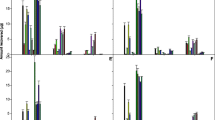Abstract
The aim of the study was to evaluate the environmental impact of filter mud compost and Tithonia diversifoila amendments on the dissipation of diuron in sugarcane cultivated soils. Filter mud compost is the by-product of sugarcane processing, while T. diversifoila is a common local plant that grows within the study region. The dissipation of diuron was significantly enhanced with DT50 of 15 and 16 days (p < 0.05) in soils amended with filter mud compost and T. diversifoila, respectively compared to 26 days in non-amended soils. Residues of 0.93 %, 1.83 % and 5.40 % of the initial applied diuron were recorded at the end of the experiment in the three treatments, respectively. The residues of 3,4-dichlorophenylmethylurea metabolite were 22.93 %, 25.92 % and 30.93 %, while 10.19 %, 12.19 % and 15.46 % of 3,4-dichloroaniline metabolite remained in soil after 112 days in the three treatments, respectively.






Similar content being viewed by others
References
Bois P, Huguenot D, Norini M, Farhan M, Haque H, Vuilleumier S, Lebeau T (2011) Herbicide degradation and copper complexation by bacterial mixed cultures from a vineyard storm water basin. J Soils Sed 11:860–873
Cabrera D, López-Piñeiro A, Albarrán A, Peña D (2010) Direct and residual effects on diuron behaviour and persistence following two-phase olive mill waste addition to soil: field and laboratory experiments. Geoderma 157:133–141
Caracciolo BA, Grenni P, Guzzella L, Pozzoni F, Bottoni P, Fava L, Crobe A, Orru M, Funari E (2005) Degradation and leaching of the herbicides metolachlor and diuron: a case study in an area of Northern Italy. J Environ pollut 134:525–534
Castillo MP, Torstensson L, Stenstrom J (2008) Biobeds for environmental protection from pesticide use. J Agric Food Chem 56:6206–6219
Cayuela ML, Millner PD, Meyer SLF, Roig A (2009) Potential of olive mill wastes as bio-based pesticides against weeds, fungi and nematodes. J Sci Total Environ 399:11–18
Daam M, Brink VPJ (2010) Implications of differences between temperate and tropical freshwater ecosystems for the ecological risk assessment of pesticides. J Ecotoxicol 19:24–37
Doran EM, Yost MG, Fenske RA (2000) Measuring dermal exposure to pesticide residues with attenuated total reflectance fourier transform infrared (ATR-FTIR) spectroscopy. Bull Environ Contam Toxicol 64:666–672
Field JA, Griffith SM, Reed RL, Sawyer TE, Wigington PJ (2003) Diuron occurrence and distribution in soil and surface and ground water associated with grass seed production. J Environ Qual 32:171–179
Getenga ZM (2003) Enhanced mineralization of atrazine in compost amended soil in laboratory studies. Bull Environ Contam Toxicol 71:933–941
Getenga ZM, Madadi V, Wandiga SO (2004) Studies on biodegradation of 2,4-D and metribuzin in soil under controlled conditions. Bull Environ Contam Toxicol 72:504–513
Herrero-Hernandez E, Andrades MS, Marın-Benito JM, Sanchez-Martın MJ, Rodrıguez-Cruz MS (2011) Field-scale dissipation of tebuconazole in a vineyard soil amended with spent mushroom substrate and its potential environmental impact. J Ecotoxicol Environ Saf 74:1480–1488
Jamil M, Qasim M, Zia MS (2008) Utilization of press mud as organic amendment to improve physico-chemical characteristics of calcareous soil under two lengume crops. J Chem Soc Pak 30(4):577–583
Kravvariti K, Tsiropoulos NG, Karpouzas DG (2010) Degradation and adsorption of terbuthylazine and chlorpyrifos in biobed biomixtures from composted cotton crop residues. J Pest Manag Sci 66(10):1122–1128
Lalah JO, Muendo BM, Getenga ZM (2009) The dissipation of hexazinone in tropical soils under semi-controlled field conditions in Kenya. J Environ Sci Health B 44(7):690–696
López-Piñeiro A, Cabrera D, Albarrán A, Peña D (2010) Cumulative and residual effects of de-oiled two-phase olive mill waste application to soil on diuron sorption, leaching, degradation, and persistence. Chemosphere 78:139–146
López-Piñeiro A, Cabrera D, Albarrán A, Peña D (2011) Influence of two-phase olive mill waste application to soil on terbuthylazine behavior and persistence under controlled and field conditions. J Soils Sed 11:771–782
Mukherjee I (2009) Effect of organic amendments on degradation of atrazine. Bull Environ Contam Toxicol 83:832–835
Orata F, Quinete N, Wilken R (2009) Long chain perfluorinated alkyl acids derivatisation and identification in biota and abiota matrices using gas chromatography. Bull Environ Contam and Toxicol 83(5):630–635
Sebai T, Devers M, Lagacherie B, Rouard N, Soulas G, Martin-Laurent F (2010) Diuron mineralisation in a mediterranean vineyard soil: impact of moisture content and temperature. J Pest Manag Sci 66:988–995
Acknowledgments
We appreciate the support received from the German Academic Exchange Service (DAAD) through an In-country scholarship and research grants from the National Council of Science and Technology (NCST) which enabled timely completion of this work.
Author information
Authors and Affiliations
Corresponding author
Rights and permissions
About this article
Cite this article
Jemutai-Kimosop, S., Orata, F. & Getenga, Z. The Influence of Filter Mud Compost and Tithonia diversifolia Leaves on the Dissipation of Diuron in Soils within the Nzoia River Drainage Basin, Kenya. Bull Environ Contam Toxicol 89, 328–333 (2012). https://doi.org/10.1007/s00128-012-0685-9
Received:
Accepted:
Published:
Issue Date:
DOI: https://doi.org/10.1007/s00128-012-0685-9




